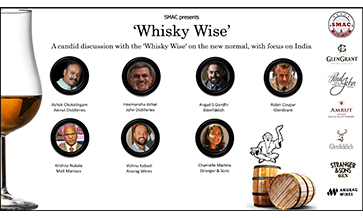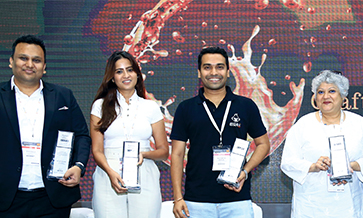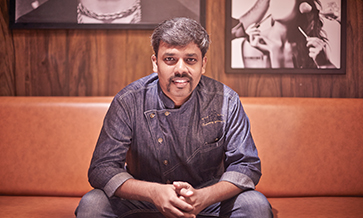“It was a cold wintry night”, said Koushika Vishwanath, head brewer at The Grid & Caldera (Kolkata) as he journeyed back in time to the moment when he decided that his future was as a brewer. Not a state of weather you’d normally associate with beer, but then when it comes to beer in India, change is the only constant.
India remains very firmly a Lager market – and overwhelmingly strong Lager – when it comes to beer. In the last decade, however, craft beer has made considerable strides. Realising that the Indian fascination with flavour and texture is not just confined to food, commercial brewers are also turning experimental.
The craft beer charge has primarily been led by India’s micro-breweries, and a few small-scale breweries that supply their beer either in bottles, cans or kegs. There are already about 150 micro-breweries across India.
Distribution micro-breweries – the Great State Ale Works, Gateway Brewing, Bombay Duck and Kimaya (all Maharashtra) – are spreading their wings to open front-end bars and growler stations.
Large micro-breweries such as Bengaluru’s Toit, Arbor and Red Rhino have dipped their toes into launching beer in bottles and cans.
Meanwhile, large brewers like AB Inbev and Bira have ventured into the micro-brewery and taproom space. AB Inbev is riding on 7 Rivers, its micro-brewery brand, to also launch a strong wheat beer in cans.
Monster micro-breweries, among them IronHill (Bengaluru) and Zero 40 Outpost (Hyderabad) cater to thousands of customers daily. Their ilk, including Byg Brewski (Bengaluru), is planning even larger ventures.
Although craft beer volumes still are but a fraction of overall beer sales (2%), in value terms it would be up to three times higher. Craft beers sell for well up to Rs. 1,000 per litre. More importantly, they’re capturing an increasing share of conversation when it comes to beer lovers in the metros.
Apart from the entrepreneurs who have helped drive this change, we owe this also to the people who make it possible, the tastemakers who are shaping and evolving the taste of beer – the brewers! In the craft spirits space, the creators may also be entrepreneurs.

Oliver Schauf of Pune’s Doolally says the idea behind craft is to bring back local ingredients and give terroir to brewing.
‘Brew’ bug
On that “cold wintry night”, when a friend asked Koushika what he wanted to do with his life, pat came the answer, “I want to make beer.” Then came many months of home brewing and learning the ropes by himself, before a formal brewing education was pursued.
For Amit Mishra, consulting Brewmaster to scores of micro-breweries across India, including Bengaluru’s Bier Library, the brewing bug caught hold only after he started work as a brewer, especially with the realisation that this was not a typical 9-to-5 job.
For Harshvardhan Jadhav, Innovation Brewer at Bira 91, it was a field trip to a brewery as a student of bio-technology that got him fascinated.
Nakul Bhonsle, Founder of Pune-based Great State Ale Works, picked up a homebrew kit in while in Brooklyn (US). It got him making a very passable Belgian Pale Ale – and before you knew it, he was on a roll!
Toit’s brewing operations in Karnataka and Maharashtra are helmed by Christopher Champalle. His love for beer was sparked at age 15, when his father would take him visiting Irish pubs on St. Patrick’s Day.
Amar Shrivastava is the Brewer at Delhi’s Ministry of Beer and co-Founder of Siqera Cider. A bio-tech student, Amar was pleasantly surprised to find that someone could make a living as a wine- maker!
When it comes to micro-breweries in India, Oliver Schauf has seen it all as a Brewmaster and founding partner in Pune’s Doolally. The idea of actually being able to make beers was so intriguing that he signed up for a 3-year internship at one of Dusseldorf’s most traditional breweries.

As a student, Amar Shrivastava was pleasantly surprised to find that someone could make a living as a winemaker.
Customer insights
Home brewing was the route some took, while for others brewery internships were crucial. If you too want to tread this path, a formal education will go a long way when it comes to becoming an ace. A degree in bio-technology is an asset in brewing.
For those with the resources, a qualification from one of the meccas of brewing education – Heriot-Watt University in Edinburgh, Scotland, or Berlin’s VLB is also highly recommended.
Our nine respondents between them have well near 100 years of experience. While Dr Subroto Cariappa started brewing in the 1970s, Anish Varshnei of Goa’s Latambarcem (home of Maka Di) took charge of brewing operations as recently as in 2020.
Given the breadth of their experience – from large commercial breweries to micro-breweries – they have had a really close and personal look at the emerging Indian beer consumer.
Oliver (of Doolally, and now also Oi Brewing) sees complex beers like Stouts and IPAs gain traction as Lagers also are reborn as craft “from their zombie serfdom under the big beer MNCs”.
The “craft” has also matured, making it hard now not to get a really good beer in India’s major metros, Oliver notes. Nakul says even small batch beers from Great State Ale Works, such as sour Ales, sell out quickly.
For Harsh at Bira, the customer quest for new and interesting flavours in beer has left him surprised and constantly experimenting. Amit has seen the community grow to an extent where the customer even now comes and brews with him!

The Great State Dive in Pune’s Koregaon Park gives Nakul Bhonsle the ability to showcase all his beers.
Inspiration, innovation
There is a robust competitive landscape for beer, especially micro-breweries and taprooms in major markets. Amit Mishra has created over 50 different styles of beer at the Bier Library, and probably 30 or so across other smaller brewpubs.
He finds experimentation fun and challenging, and helping take the monotony out of what he does. “The excitement is always high, given the fact that you don’t really know how the beer will turn out after three weeks (see box: Beer Bloopers!)
Oliver’s inspiration comes from “either interesting ingredients I come across, or else a great beer I had somewhere else”. For Koushika it’s constant and varied interaction with a wide set of people, including local fruit and vegetable vendors, chefs, bartenders, bakers and agriculturists.
Nakul’s background as a home brewer gave him the impetus and the confidence. His 20-litre homebrew kit is now at their brewery, and in constant use with experimental batches. “Never brew the same beer twice,” is his philosophy.
Customers, especially in mature micro-brewery/ taproom markets such as Bengaluru and Pune have been exposed to changing beer tastes and styles for more than a decade. They are definitely open to experimentation now.
Most brewers I spoke to have a constant set of four or six beers on tap that are crowd pleasers. They focus on innovating via seasonal brews and small batch specials.
At the Bira taproom in Bengaluru, Harsh aims at a new beer every week, keeping customers and team excited. “Storytelling about these new brews is also important,” says Harsh. Amit Mishra is very particular about knowing when the right fruit hits the market when it comes to making fruit beers.
Anish at Maka Di, who deals in both packaged beer and kegs, tries to come up with a seasonal beer every quarter. The latest is a Rose Brut IPA, brewed and fermented with grape pulp to add a mild tart flavour.
For Amar, the season dictates the styles of beer he creates. In winters, strong and darker beer with more robust flavours (Belgian Tripel or Imperial Stout), and in summer, mostly light body, clean, crisp and thirst-quenching beers (Belgian Wit), cream ales and pale ales.
Nakul at Great State Ale divides his beers into four types: flagship, small batch, seasonal and millet. A new seasonal beer every quarter and typically two small-batch beers every month is what he does. The Great State Dive in Pune’s Koregaon Park gives Nakul the ability to showcase all his beers.
Koushika aims for a new variant every month at the Grid. Customer interaction and response compels him to take festive specials permanently; but limitations imposed by the brewing tanks compel him to keep only best-sellers on tap. (see box: Food Fare)

Christopher Champalle of Bengaluru’s Toit Brewery makes a regular special using ragi with an interesting dry and spicy profile.
Going local
Seasonal brews are definitely one aspect that is supportive of sustainability. The other is the use of local grains and/or ingredients. Typically, most craft brewers import the barley malt and hops. Wheat malt and some adjuncts might, however, be sourced domestically.
At Oi Brewing, Oliver has bucked the trend. “Craft should not be confused with gourmet,” he says. The idea behind craft should not be flying in the world’s best ingredients, but “to bring back the local beer and give terroir to brewing”.
At Doolally, the beers are “proudly brewed with Rajasthani malt and Maharashtrian wheat, with the cider made from Kashmiri apples”.
At Oi, Oliver has taken this even further, choosing to become Asia’s first organic brewery. He has opened talks with former hop farmers in Lahaul Spiti to resume hop cultivation for Oi.
“Our vision is to make all beers farm to table,” says Oliver. “These will be great beers made from scratch by people we know by name.”
At Great State Ale, Nakul brews a new millet beer every quarter. He has also used bajra (pearl millet) to make a well-received New England IPA in Pune.
At Toit, the Basmati Blonde is brewed using basmati rice. Christopher says, “When used right, any local grain can be a very good adjunct.” Toit also brews a regular special beer using ragi, which gives an interesting dry and spicy profile.
Anish of Maka Di indicates that using local grains can gain immense popularity for people with dietary restrictions (bajra and ragi are gluten-free). Bira also has a new rice Lager called Rise, and their Bajra Brut IPA has been well received, says Harsh.
Amar uses jaggery and honey as sugar substitutes, and a range of fruits and spices, including jamun, guava, chamomile and lemongrass. Kokum is quite a popular addition too, featuring in Bira’s Kokum Sour.
Great State Ale’s Kokum Gose uses ginger to mimic the flavours of a kokum soda, a common drink on Maharashtra’s west coast. Nakul also uses Gondhoraj to his hoppy American Wheat Ale.
At Kolkata’s The Grid, Gondhoraj is also a logical ingredient given its local provenance – and so is Nolen gur, jaggery that is used in their farmhouse ale.

Dr Subroto Cariappa (L), who started brewing in the 1970s, has helped set up dozens of micro-breweries across India. Customer response inspires Koushika Vishwanath of Kolkata’s Grid & Caldera.
Crystal gazing
The styles that currently rule the roost are Belgian Wit and German Hefeweizen. Even large brewers like United Breweries have introduced their wheat beers (Kingfisher Ultra Wit) and AB Inbev has begun brewing Hoegaarden and extended its micro-brewery brand to 7 Rivers Strong Wheat.
What could be the next breakthrough style that achieves critical mass? In one corner are those that are firmly in favour of IPA (India Pale Ale): Bira’s Harsh, Amit Mishra (who hedges his bet with a Pale Ale too), Anish Varshnei (who suggests that it be more aroma-forward and less bitter on the palate), Nakul (who opts for mellower, juicier New England IPAs) and Dr Cariappa.
The outliers are Amar (American Pale Ale or Blonde), Koushika (craft Lager), Oliver (who votes for cider) and Toit’s Christopher, who prefers beers based on Indian local grains.
We will always be in debt to those entrepreneurs and brewers, who have taken it upon themselves to expose us, day in and day out, to the wonderful possibilities in beer. For all I know, some of you may draw inspiration from this article to also join their ranks. Do let me know where to come for a taste then!

Goa’s Latambarcem Brewery is helmed by Anish Varshnei (inset), whose latest is a Rose Brut IPA, brewed and fermented with grape pulp.














